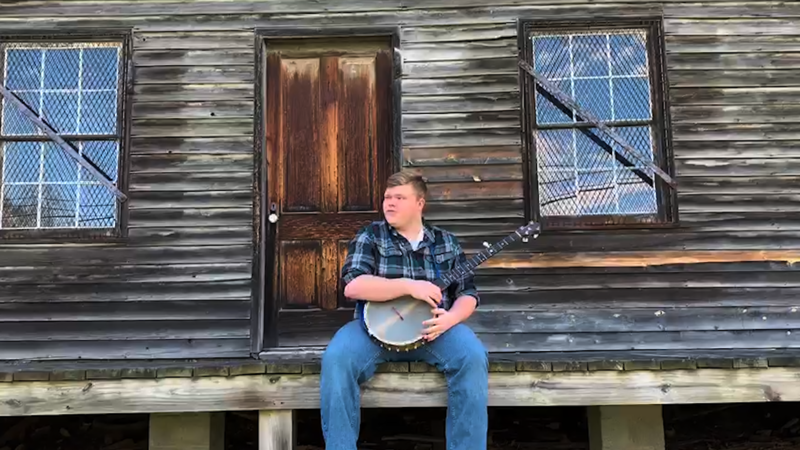We’re all making tiny time capsules. You may not recognize it, but we’re all doing it, saving up the memories and experiences of our COVID-19 journey in some way.
Perhaps your Instagram has become a collection of your isolation crafts, or the evolution of your sourdough, the devolution of your hairstyles. Maybe you’re journaling fastidiously or saving all of your wine corks from virtual happy hours in a special jar labeled vin du corona.
Even if you’re not actively preserving the moment, when this is all over, the exponential increase in email communication will sit there in your inbox. There will be an enduring electronic legacy of Amazon and Doordash and Instacart receipts, all to remind you, should you ever care to look, of the months we all stayed home.
Tijah Bumgarner and Curren Sheldon have hit on an especially refreshing — and entertaining — way of encapsulating the new American reality. Both run in the same film industry circles in West Virginia — Bumgarner teaches film production at Marshall University and has done extensive narrative and documentary work; Sheldon is an Academy Award- and Emmy-nominated documentary filmmaker. Pre-COVID (that’s how we’re all marking time now, right?), the two were neighbors, friends and occasional script-workshopping buddies. When the pandemic forced on-site filmmaking to an immediate halt and college campuses adjourned to dystopian Zoom-classrooms, the two had to get creative about how to be creative.

Sheldon said that after the mind-numbing boredom of the first three weeks of quarantine – ”the longest weeks of my life” – he and Bumgarner decided to work on something light to distract them from the monotony. The idea for a short, scripted series “just sort of sprung up,” he says. “We just started doing it for something to do.”
For most of us, just needing “something to do” has probably produced little more than a windowsill full of scallion and romaine butts floating in murky water — maybe a freshly organized pantry or wardrobe for the overachievers. Not so for Bumgarner and Sheldon.
Their “Quarantine Life” series, available on their YouTube channel Hot Contents, is a collection of comedic shorts the co-creators say are based on true stories — a claim which might be dubious to someone time-traveling a few months ahead from January, but is fully acceptable to any week-eight isolation warrior. Who among us, after all, hasn’t gone to absurd lengths for a safe glimpse of a friendly face, or had a minor meltdown when faced with the most basic of errands?
The shorts are wonderfully concise, like little snacks — but less like a whole bag of Cool Ranch Doritos and more like those Alison Roman hors d’oeuvres you’ve been practicing while dreaming of future dinner parties and forcing on your kids in the meantime. “Quarantine Life” offers a chance to revel in the bewildering mundanity that so many of us stare down daily, now that our lives have moved fully into our houses.
“Times are weird, and tough, but there’s still some sort of collective absurdity that we can all smile at,” Sheldon says.
Although both creators have a history of working on Appalachia-focused documentary projects, you won’t find any overt references to mountain life. “It’s more about the American-universal reach — the shared experience,” Bumgarner says. “We hope those waves go even further than just the region.”
Both collaborators say the project is a healthy outlet, both for the new small anxieties of everyday life and for pent-up creative energy. Bumgarner says that, although there’s not much else going on in isolation, the invented timeline they work on — sharing two finished shorts a week to their YouTube channel — has injected an energy and a welcome urgency into her work week.
“When we’re normally writing scripts,” she says, “you never really know when you’re going to be able to shoot them, or if you’ll even be able to raise the money to be able to work on the next feature.” The shorts, on the other hand, offer near-instant creative gratification and provide immediate engagement with an online audience hungry for relatable content, and eager to share their feedback.
Their condensed production schedule, however, in no way equates to a reduction in quality; the series is beautifully shot. After adjusting to seeing celebrities, news anchors, coworkers and grandmas alike rendered only in tiny, grainy Brady-Bunch-boxes on our computer screens, it is startlingly intoxicating to see new faces doing every-day things in high definition. It’s as if the axes of perception have flipped: Since we now live in the uncanny valley, realistic representations of humans doing now-normal things feel a bit eerie.

While there are certainly challenges to socially-distanced filmmaking, Bumgarner and Sheldon have relied on the participation of co-quarantined partners and friends — and a little sneaky editing to splice together scenes from their separate homes — to bring the series together with relative ease. Sheldon says they’ve done their best to use what’s already at their disposal, “in order to show what this current moment is like for a lot of people,” with the hope that we can all eventually look back and say, “I can’t believe that was our reality.”
But for now? The two already have plenty of ideas for upcoming videos and are sure the partial reopening efforts we all look forward to will be rife with new micro-anxieties they can spin into observational comedy.
“It’s cathartic to replay your own life out on the screen,” Bumgarner says.
They plan to keep producing “Quarantine Life” shorts for as long some sort of isolation measures are in effect. After all, Sheldon says, “You have to keep living your life — as safely as possible — but you have to keep doing stuff that is creative and makes you happy, or you’ll drive yourself mad.”
Chelsey Mae Johnson is an MA candidate in Appalachian Studies and Public History at Appalachian State University. She researches and writes about food traditions, folk artists and kitsch culture.



